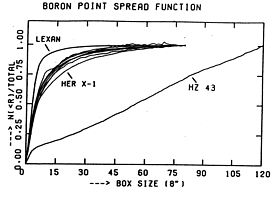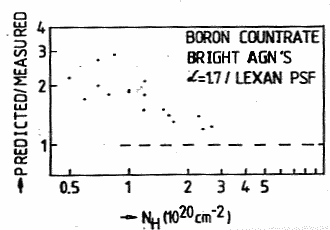POINT RESPONSE WITH THE BORON FILTER
An apparent count rate deficiency has been evident in data for all
observations carried out with the Boron filter (ref. Express no. 8
p.31) and a clear explanation of the effect has now been established
viz: the point spread function (PSF) is much wider because of
scattering of the X-rays within the boron filter. This scattering is
energy dependent and strongest at low energies. Figure 1 shows a
comparison of the integral PSF for a number of point sources observed
during the mission. Clearly, the PSF for HZ43, a soft X-ray emitter
with kT ~0.006 keV and low column density ~1018
cm-2, is so wide that an integration box size of ~16 arcmin
is necessary to retrieve all source photons. Her X-1 with a column
density of ~1020 cm-2, shows the on-set of the
effect in comparison with 7 harder and/or more cut-off sources, which
comprise all strong sources ( 0.3
cts/s) observed with the boron filter. Note that for these hard
sources, the PSF is still wider than the PSF for a lexan filter
measured in flight. All other filters have comparable PSF's to that of
lexan.
0.3
cts/s) observed with the boron filter. Note that for these hard
sources, the PSF is still wider than the PSF for a lexan filter
measured in flight. All other filters have comparable PSF's to that of
lexan.
Using a single integration box size for all filters, for example as
for lexan, will thus give an underestimate of the source counts for
observations with the boron filter. The onset of this effect at
~1020 cm-2 is further illustrated in figure 2,
which shows the ratio of predicted to measured boron filter count
rates for a sample of bright AGN's. A photon spectral index of 1.7 was
assumed and the corresponding NH was found from the
lexan/Al-Parylene count ratios. An increase of the count rate
deviation at lower NH is clearly visible. Note that this
figure merely illustrates the energy dependence and cannot, because of
the underlying assumptions, be regarded as a calibration.
In view of the above, we give some guidelines to aid the analysis of
the boron filter data. Strong sources with good signal-to-noise ratio
should be integrated with a large box size, which can be estimated
from figure 1. Increasing the box size will indicate when the full
source flux is collected. Source fluxes to an accuracy of ~20% for a
hard or highly cut-off (NH  1021 cm-2) source can be found
with a correction for the almost constant shape of the PSF (see figure
1). The CCF PSF is fairly representative in this case. For soft and/or
fairly nonabsorbed sources the CCF currently does not contain
sufficient information to accurately process the data. The PSF as a
function of energy has been calculated at the Space Research
Lab. Leiden, using predictions of the scattering in the boron
filter. This data is being implemented at ESOC. A comparison with
in-flight calibration sources such as HZ43 will be carried out to
validate the model data. Finally, the PSF for the boron filter will be
updated in the CCF, probably in the form of the scattering data and an
algorithm to construct the boron PSF for a given source spectrum.
1021 cm-2) source can be found
with a correction for the almost constant shape of the PSF (see figure
1). The CCF PSF is fairly representative in this case. For soft and/or
fairly nonabsorbed sources the CCF currently does not contain
sufficient information to accurately process the data. The PSF as a
function of energy has been calculated at the Space Research
Lab. Leiden, using predictions of the scattering in the boron
filter. This data is being implemented at ESOC. A comparison with
in-flight calibration sources such as HZ43 will be carried out to
validate the model data. Finally, the PSF for the boron filter will be
updated in the CCF, probably in the form of the scattering data and an
algorithm to construct the boron PSF for a given source spectrum.
J. Davelaar & P. Giommi
Figure 1.

Figure 2.

[EXOSAT Home]
[About EXOSAT]
[Archive]
[Software]
[Gallery]
[Publications]